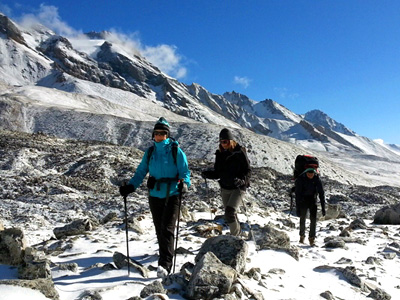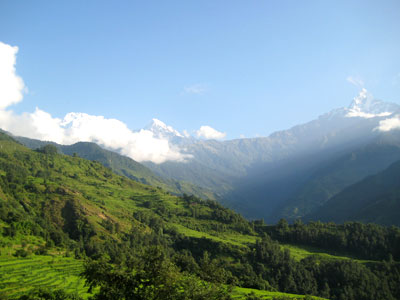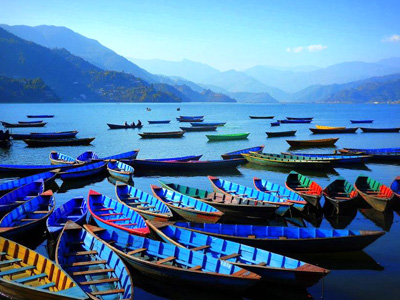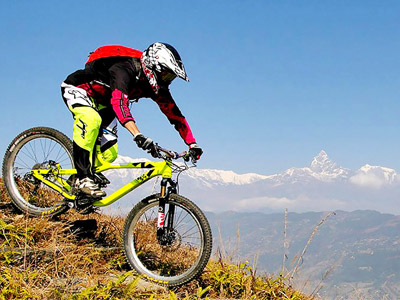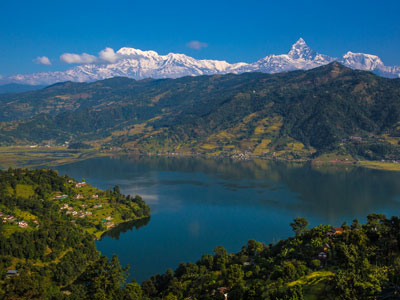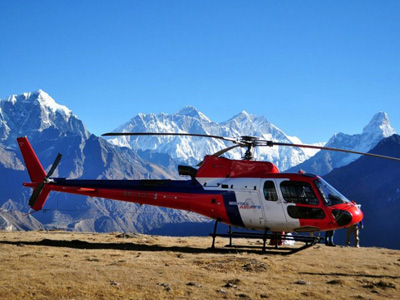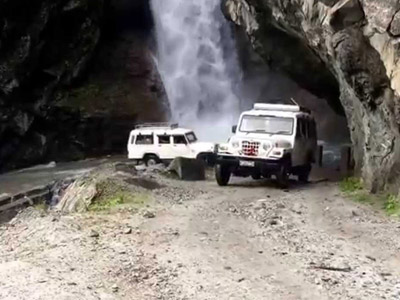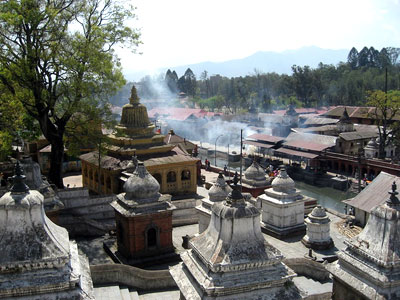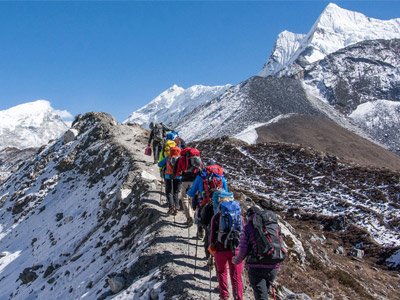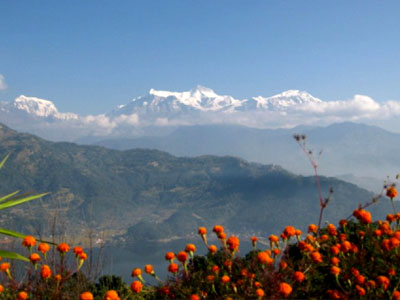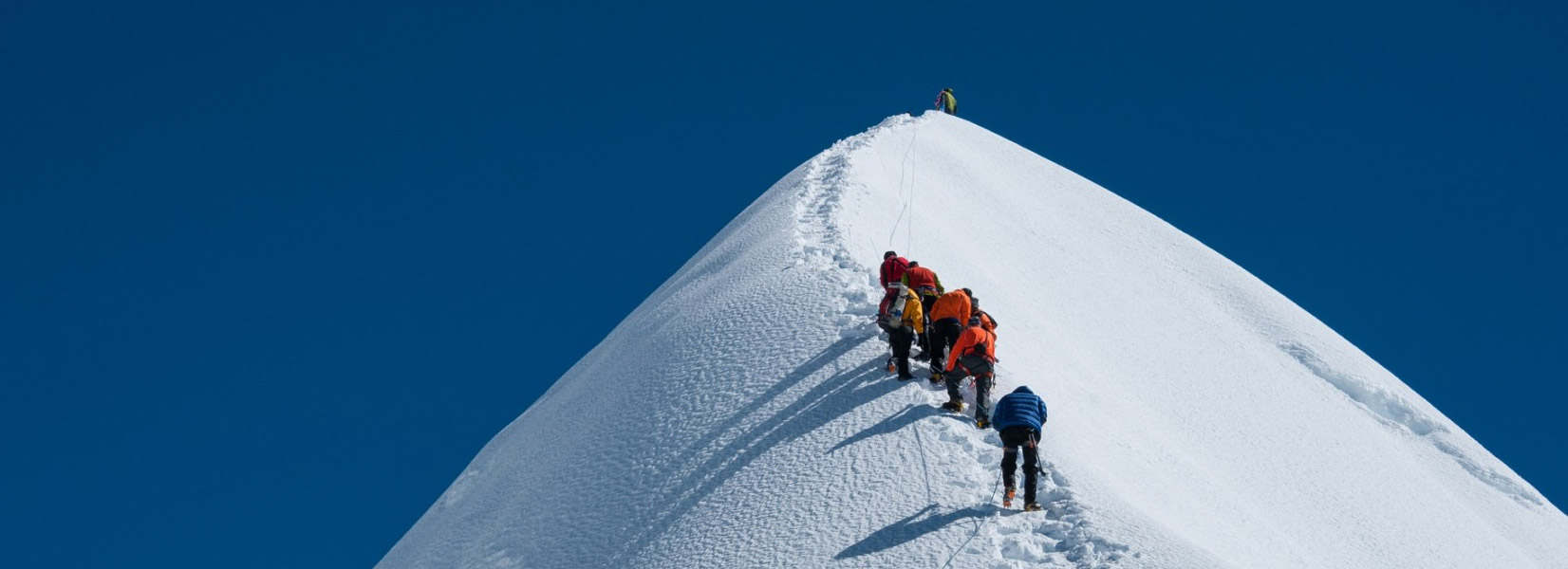
Island Peak Climbing
Trip Difficulty: Easy
Destination Nepal
Overview of Island Peak Climbing
Island peak is one of the highlight peaks that lies in the Khumbu region of the Everest area. Island peak also known as Imja Tse (6189m) has the unique look as it looks like an island all covered by snow from all sides when seen from Dingboche. This peak climbing has become one of the highlights spots where lots of tourists are attracted in achieving the heights of this very peak.
Island peak is tentatively little easier to climb as compared to other peak of the region. This however requires high level of physical fitness and need some technical aspect while ascending. The trail to the peak is all covered with ice and snow thus it must be taken high care of the route.
Island peak provides majestic views of the Everest region. One can enjoy the spectacular views of Mt. Ama Dablam and Mt. Makalu. The ascent will be quite difficult thus observing all the panoramic view will totally worth the trip. descend will be much easier, safer and faster than the ascend.
Island peak is first ascended by British Everest expedition team in 1960. From then the charm of this peak has grown to every brave heart to conquer over to its top.
Island peak climbing requires heavy logistics, communication management, along with trained staffs and guides. The Sherpa people of the Khumbu region have always been experienced to achieve this very height. These beautiful souls have made all the peak climbing and expedition successful all throughout the days.
Best climate for Island Peak Climbing
The climate in Nepal can sometime become notorious. The best valued of time and season must be taken care while visiting the harsh and wildest nature of Nepal. There are mainly two season famous for operating expedition in Nepal.
SPRING SEASON
Spring is the best season for expedition in Nepal. This includes the month from late February to May month. The climate will be most vivid at this time with the lushly view of the massive mountain terrain. The wind is not harsh and the trail will be less difficult than other season where it is mostly covered with snows. This season has the highest record of expedition in Nepal. The region will be more crowded with people thus the cost efficient travel is most.
AUTUMN SEASON
Autumn is another season for the best time to summit the peaks. This season include from the month of late September to early December. The nature is with lushly hills with the vivid sky. The weather will be with less heat haze which includes best spectacular views of the massive peak ranges around the world. this is the second most crowded season of the year. There will be fewer crowds as compared to the spring season.
Physical fitness required for Island climbing
Island peak climbing needs strenuous level of physical fitness. This is a grade 5 level of peak climbing thus one must be supposed to be physically fit free from any disability. The climber is supposed to have a well knowledge to use the tools and equipment s. The climbers must be in healthiest shape and must endure the harsh wilderness and nature so as to successfully complete this very peak climbing.
Food and Accommodation for Island Climbing
Food and accommodation is all provided through the Island peak climbing package. The stay in the Kathmandu will be of two days where you will stay at hotel based on your level of preference. From then after reaching the Khumbu region you will stay at the tea houses and lodges till to the base camp. From Chukkung, you will stay on the tent and camp so we will prepare our own food by guide or Sherpa till the final level of ascend and descend till to the base camp. The days on the camp will normally be 3 to 5 days normally on the level of fitness and health.
Island Peak Climbing Permit Cost
Climbing permits for various peaks in Nepal are available through the Nepal Mountaineering Association (NMA), which oversees trekking, mountaineering, and climbing activities in the country. The NMA is responsible for conservation efforts, protection of the environment, rare flora and fauna, as well as coordinating emergency rescue operations.
In order to manage the risks associated with climbing and to protect the natural and cultural heritage, Nepal has implemented a permit system. This system categorizes climbing peaks into two groups: Group A and Group B.
Group A includes 15 peaks such as Mera Peak and Island Peak, which require Higher Peak Climbing permits. Group B consists of 18 peaks including Yala Peak, Pisang Peak, Chulu East Peak, and Chulu West, which require Lower Peak Climbing permits.
To obtain these permits, interested individuals must apply through registered agencies. The NMA issues the permits and determines their associated costs. The fees for climbing permits vary depending on the peak and the season. Let’s take the example of Island Peak:
Island Peak Climbing Permit costs vary throughout the year. In the spring season, the permit fee is USD 250. In autumn, it costs USD 125, while in summer and winter, the fee is USD 70.
The permit system serves to mitigate risks to rare plants and animals, safeguard cultural heritage, and ensure the safety of mountaineers. It also helps regulate climbing and mountaineering activities in Nepal, which often pass through national parks, conservation areas, and restricted zones.
Travel Insurance for Island Peak Climbing
Embarking on adventurous endeavors such as peak climbing offers individuals an opportunity to immerse themselves in thrilling experiences, breaking free from the monotony of everyday life. The allure of scaling mountain summits lies not only in the challenge it presents but also in the chance to connect with nature, immerse oneself in diverse cultures, and find solace in the awe-inspiring landscapes that unfold before climbers’ eyes.
However, it is crucial to recognize that peak climbing carries inherent risks that add to its allure. The rugged and treacherous terrains, snowy expanses, and high altitudes amplify the potential dangers, including altitude sickness and the looming threat of avalanches. Thus, those venturing into these endeavors must prioritize their safety and well-being.
A fundamental step in ensuring safety during peak climbing expeditions is acquiring appropriate travel insurance. In fact, obtaining comprehensive travel insurance is a mandatory requirement for obtaining climbing permits. As part of the permit application process, climbers must provide a copy of their travel insurance policy as a vital document. This insurance coverage should encompass a range of provisions, including emergency helicopter rescue, medical treatment and evacuation, and rescue expenses. These measures serve as a safety net, providing climbers with the necessary support in the face of unforeseen circumstances.
While planning peak climbing adventures, it is important to note that Graceful Adventure Travels does not offer travel insurance packages or engage in insurance-related activities. We strongly urge trekkers to conduct thorough research to identify reputable insurance companies that cater to their specific requirements. It is essential to select an insurance policy that adequately covers the risks associated with peak climbing and guarantees essential assistance during emergencies.
By prioritizing safety and taking proactive measures, climbers can relish the extraordinary experiences that peak climbing affords while mitigating potential risks. It is imperative to approach these adventures with caution, preparedness, and a deep respect for the forces of nature, ensuring a memorable and secure journey to the summit.
About Company
Graceful Adventure travels Pvt. Ltd. is a registered Adventure travel company from Nepal who organizes the expedition packages to the valued guest all around the globe to the massive Himalayas. Our commitment and our work success has made the guest fall into the love of our charm. Our ultimate motto of travelling the best and safe trail has become famous and selected guest with the best knowledge are involved with us. We are committed in providing best facilities available so as to make your trip go successful. We don’t leave any stone unturned until we have met the expectation and need of our valued guest.
FAQs - Island Peak Climbing
Island Peak is situated at a height of 6165 meters above sea level.
The arduous ascent of Island Peak is best done between the spring and fall foliage seasons. The best weather for a successful climb may be found during these times. Since the sky are normally clear between the spring and fall, travelers are less likely to see severe snowfall or downpours of rain.
Observing the surrounding countryside change is one of the fascinating benefits of picking these seasons. The woodlands are painted with beautiful hues as nature emerges from its winter hibernation. The walk is more visually appealing overall because to the blossoming flowers and thick foliage, which also provides a lovely backdrop for your ascent.
Additionally, starting the climb in the spring or fall sometimes coincides with regional traditional celebrations. This enhances your entire experience by adding another level of cultural immersion to your travel and allowing you to see and take part in the local celebrations.
Your chances of having a successful and enjoyable journey while navigating through ideal weather conditions and embracing the breathtaking natural beauty that surrounds you are increased if you decide to climb Island Peak in the spring or fall.
Our default timeline requires 18 days to accomplish Island Peak Climbing. However, we also provide our visitors the option of tailoring their schedule to suit their preferences.
Due to its high height, harsh climate, and difficult terrain, climbing Island Peak is notorious for being difficult and demanding. It calls for extraordinary stamina, power, technical proficiency, and acclimatization. For a safe and successful ascent, careful planning, preparation, knowledgeable assistance, and appropriate equipment are essential. Climbers are rewarded with a sense of success and breathtaking vistas after completing this difficult task, which calls for commitment, perseverance, and physical endurance.
Hotels in towns or metropolitan regions, such as Kathmandu, have easy access to electricity. During their stay, guests are allowed to use the available electricity. In villages and rural regions, however, electricity is often generated by tiny hydropower plants or solar panels. Because of the massive influx of tourists in certain places, the use of energy may come at a low cost.
Electricity is not accessible on treks, especially while sleeping overnight. It is best to use the power supplied in Homestays or teahouses along the way to charge electrical gadgets. In addition, to provide a stable supply of electricity in the event of limited access, we recommend bringing a fully charged, robust power bank.
Please keep in mind that the availability and dependability of electricity may vary depending upon specific location and infrastructure.
We provide a variety of hotel alternatives in urban regions and cities, ranging from 5-star to 3-star lodgings, to suit your budget and tastes. These hotels provide elegant accommodations as well as a broad menu of national and foreign cuisine. During your visit, you can sample a range of gastronomic delicacies.
However, star-rated hotels are not accessible in villages or rural regions. Instead, we provide pleasant homestays, lodges, or tea houses to fulfill your needs. These lodgings may not have luxurious facilities, but they do provide a satisfying experience. Local, Indian, and Tibetan food, including the famed and traditional Dal Bhat Tarkari dish, are still available. To protect your health, we focus nutritional needs and uphold hygiene standards.
You will have the option to do so during camping vacations. You will be able to savor the food you pack with you when going on camping vacations. Our crew will see to it that the necessary preparations are completed for your camping meals.
Although the amenities and choices may differ between urban and rural settings, we make every effort to deliver a satisfying experience and give your comfort and dietary requirements top priority.
We follow our standard route. However, we also provide our visitors the option to choose their own schedule.
Hotels in urban areas provide free internet access. Internet access may be available in villages; however, it could be expensive at rural teahouses. There won’t be any internet or electricity while you’re camping.
Yes, travel insurance is required for all treks and peak-climbing expeditions. Emergency helicopter rescue, medical attention, and rescue must all be covered by travel insurance.
Each and every climber must get a permission for Island Peak Climbing. The cost of the permit differs depending on the season. Each individual needs a permit, which costs USD 250 in the spring, USD 125 in the fall, and USD 70 in the summer.
Peak climbing is generally more risky than other treks. While climbing with us, we supply you with all the required equipment of high quality, as well as our highly trained guides and porters, which helps to lower the risk factors.
No one is permitted to hike by themselves or without a guide during the Island Peak Climb. Everyone who is climbing Island summit or any other summit has to have the guide.
Peak climbing is an undeniably difficult endeavor, with several challenges to overcome. Physical fitness must be prioritized in order to overcome these obstacles. Peak climbing, often known as mountaineering, necessitates a high level of physical and mental fitness. It is an exciting and risky quest that requires unwavering physical and mental strength. As a result, anyone going on this expedition must be exceptionally physically fit and resilient in order to overcome the terrible difficulties that await them.
Graceful adventure travel provide the Deluxe package on 2520 usd per person.
Day 1: arrival day
Upon your arrival, we are pleased to inform you that a designated representative from our company will be eagerly awaiting your arrival at Tribhuvan International Airport. The representative will be readily identifiable, as they will be holding a prominent sign displaying our company’s name.
Rest assured, the representative’s main purpose is to extend a warm welcome to you and provide seamless assistance throughout your journey. They will be responsible for picking you up from the airport and ensuring your safe transportation to your designated hotel.
Day 2: visit historic Kathmandu valley and Trek preparation Day
After enjoying a delightful breakfast at 7 am, you will embark on an unforgettable exploration of the UNESCO World Heritage Sites in Kathmandu. This captivating tour encompasses visits to the esteemed Pashupatinath Temple, Swyambhunath, Bouddha, and Kathmandu Durbar Square.
Throughout the tour, you will be accompanied by our knowledgeable guide, who will provide fascinating insights into the historical and cultural significance of each site. The exploration will grant you a deeper understanding of Nepal’s rich heritage.
Upon the completion of the sightseeing tour, you will be escorted back to your hotel. Take this opportunity to savor a delicious lunch and indulge in a few hours of well-deserved rest. During this period, our experienced guide will dedicate their time to provide you with essential information about the upcoming trek.
This valuable session will equip you with the necessary knowledge and preparations for the upcoming peak climbing adventure. Additionally, you will have the opportunity to purchase any required tools or equipment essential for the peak climbing experience.
Day 3: fly from Kathmandu to Lukla and trek to Phakding
Today, trek starts with adventurous flight from Kathmandu to Lukla. This flight provides the opportunity to fly over green hills with picturesque view of mountains of Everest region. Today it will be first day of foot trek. From Lukla trek to Phakding and stay a night there in Pakhding in trekking guest house.
Day 4: trek from Phakding to Namche Bazar
Today the trek will be quite difficult as it goes always ascending to Namche with spectacular view of green hills and mountains full of natural beauty. Today we will enter at Sagarmatha National Park which is listed in UNESCO world Heritage site. Today stay at Namche bazar. Namche bazar is known as capital of sherpa and commercial center of Everest region.
Day 5: acclimation day in Namche Bazar
While embarking in higher altitude above 3000 meters, there is very high risk of altitude sickness. Altitude sickness can affect all our plan and Island Peak Climbing Program. So, to tackle this obstacle we will do one day acclimatization in Namche Bazar.
You can visit the beautiful and colorful Namche Bazaar, surrounded by snow-covered mountains. We will utilize the day to visit nearby Sherpa villages and learn about the culture and traditions of Sherpa people. If you are lucky, you may get the chance to see some cultural programs. You can even wear Sherpa local dress and take photos, although there may be some charges according to local customs.
Day 6: trek from Namche Bazar to Tengboche
On 6th day of the trek, we will trek to Tingboche from Namche bazar. Today the trek is gone a be tough as we will gain elevation more than 1200 meters. But stunning view of mountains and nature makes you to forgot all the stress and fatigue and also add more excitement in the trek. Today we will stay in Tengboche.
Day 7: trek from Tengboche to Dingboche
After the breakfast, we will begin the trek towards Dingboche from Tengboche. Today we will do a beautiful trek crossing through glacier river with the beautiful mountains like Ama Dablam. Trekking through the beautiful landscape will add some excitement in the trek. This night we will stay in homestay at Dingboche.
Day 8: trek from Dingboche to Chukkung
From Dingboche to Chukkung, the trek is short and altitude will be quite high. we will enjoy stunning view of snow-covered mountains like Lhotse, Island Peak, Chukkung Ri, and Makalu. We will reach there and have lunch. Visit around village and have some chat with local people and experience local lifestyle and stay that night in Chukkung.
Day 8: trek from Dingboche to Chukkung
From Dingboche to Chukkung, the trek is short and altitude will be quite high. we will enjoy stunning view of snow-covered mountains like Lhotse, Island Peak, Chukkung Ri, and Makalu. We will reach there and have lunch. Visit around village and have some chat with local people and experience local lifestyle and stay that night in Chukkung.
Day 9: Acclimation day in Chukkung
For further trek in higher elevation above 4500 meters we need proper acclimation and rest. The more increase in altitude there is more risk of altitude sickness and other risk factor. So, we need proper acclimatization and rest. We will do two night and one day acclimatization in Chukkung. During acclimatization day, we will hike to Chukkung Ri peak of altitude 5550 meters. There is low air density and it will be very helpful for proper adaptation further in higher altitude. From Chukkung we will get beautiful view of Island Peak, Lhotse, Ama Dablam, etc.
From Chukkung Ri peak get back to Chukkung village, stay an overnight and prepare for next destination.
Day 10: trek from Chukkung to Island Island Peak Base Camp
Embarking on an uphill hike from Chukkung, you make your way towards the mesmerizing Island Peak Base Camp. The trail offers breathtaking views of the Lhotse and Imja glaciers, creating a stark yet captivating landscape. Arriving at the base camp, you find your pre-pitched one-person tent to store your belongings. After a fulfilling lunch, you participate in essential pre-climb training, where an experienced guide instructs you on rappelling, belaying, and equipment usage. Following the training, you prioritize rest, retiring early to prepare for the midnight wake-up call. Tomorrow’s summit push requires focus, strength, and mental clarity, making ample rest vital for the challenging ascent ahead.
Day 11: Island Peak Base Camp to island Peak Summit and return back to Chhukung
Embark on your climb as early as 1 AM to avoid adverse weather conditions later in the day. The ascent demands both physical strength and the use of belay devices. Remember to pack a lunch and snacks for sustenance.
Upon reaching High Camp after a period of hiking, continue for approximately 3 hours to reach Crampon Point. At this stage, you’ll need to don crampons due to the icy and slippery terrain. From an elevation of 5700m onwards, man-ropes will be secured for the team’s safety. Traverse along a narrow ridge until you arrive at the base of Imja Glacier, offering breathtaking vistas of Makalu, Baruntse, Ama Dablam, Mera Peak, Chamlang, and other majestic peaks.
The slope gradually steepens to an angle of 45 to 50 degrees, making the ascent moderately challenging. Expert guides will ensure ropes are fixed at the glacier. As you approach the summit of Island Peak, the magnificent Lhotse looms in close proximity. The toughest part of the climb involves ascending a vertical wall, attaching and detaching your harness from the fixed line.
Depending on weather conditions, there may be one or two crevices, which can be crossed using ladders while holding onto the safety rope. Continue along the ridgeline until you reach the summit, where you can relish the awe-inspiring mountain views and capture cherished photographs. For the descent, make your way back to Chhukung via Base Camp, exercising caution and attentiveness to your footing during the long journey down.
Upon reaching Chhukung, take a well-deserved rest to rejuvenate your tired legs and celebrate the remarkable achievement of conquering Island Peak.
Day 12: contingency day
To ensure flexibility in your itinerary, it is wise to allocate an additional day as a precautionary measure in case of unexpected circumstances such as unfavorable weather or flight disruptions, which could potentially impede your summit plans. This extra day can also act as a buffer for handling minor injuries or adverse weather conditions that may arise during the climb.
In the event that your journey progresses smoothly and according to schedule, this spare day presents a wonderful opportunity to immerse yourself in the vibrant cultural tapestry of a Sherpa village along your route. By venturing off the beaten path, you can partake in an enriching experience, gaining firsthand insight into the customs, traditions, and daily lives of the Sherpa community. Embrace this chance to forge connections and deepen your understanding of their unique heritage.
Day 13: trek from Chhukung to Namche Bazar
Descend from Chhukung to Pangboche, a historic Sherpa village known for its ancient Buddhist monastery. Continue to Namche Bazaar, where you can indulge in creature comforts like hot showers, delicious meals, and a cozy teahouse stay. Take this opportunity to relax and rejuvenate before resuming your expedition.
Stay overnight in Namche Bazar at tea house.
Day 14: trek from Namche Bazar to Lukla
On 14th day of the trek, take long descend to Lukla from Namche Bazar through the same trek enjoying the best seen of Himalayas and forest full of rare flora and fauna. Today is the last day of the foot trek. We will stay that night in homestay in Lukla and enjoy local food and drinks with local song and dance.
Day 15: fly from Lukla to Kathmandu
Fly over the green hills with picturesque view of mountains about 32 minutes. Have rest and stay night in hotel in Thamel Kathmandu. And prepare for departure.
Day 16: departure day
On your departure day, which happens to be the 16th day, you are free to do some shopping in Thamel or any other location of your choice in Kathmandu, depending on your flight schedule. One of our company representatives will then provide transportation to the airport in accordance with your scheduled departure time. Please feel free to make any necessary changes to your itinerary or inquire about any additional information you may require.
Note: our itinerary is very flexible one can customize their own itinerary and can extend the trek for more few days and can also add some other tour or trek according to your time and interest. And the cost will be charged according to your luxurious service and customization.
Reviews on Island Peak Climbing
Submit your review | |
1 2 3 4 5 | |
Submit Cancel | |
Interested in this package? Make free inquiry
Reviews on Island Peak Climbing
Submit your review | |
1 2 3 4 5 | |
Submit Cancel | |
